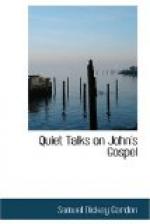So we trace the blue thread in John’s tapestry picture, the true faith that is drawn out from nothing to little and more and much and most, under the warmth of the brooded wooing of this great Lover.
The Ugly Thread in the Weaving.
Now for that ugly dark thread, the opposition to, the rejection of, the Lover’s wooing. But we’ll not linger here. We’ve been seeing so much of this thread as we traced the other and studied the whole. Ugly things stand out by reason of their very ugliness. This stands out in gloomy disturbing contrast with all the rest. A brief quick tracing will fully answer our present purpose. And then we can hasten on to the dominating figure in the pattern.
The opposition begins with silent rejection, moves by steady stages, growing ever intenser clear up to the murderous end. The sending of the committee to the Jordan to examine John and report on him was an official recognition of his power. The questions asked raise the possibility clearly being discussed of John being the promised prophet, or Elijah, or even the Christ Himself, and this is an expression of the national expectancy. The utter silence with which John’s witness to Jesus is met is most striking.[73] Its significance is spoken of by both Jesus and John.[74]
The intensity of the resentment over the cleansing of the temple-area can be almost felt rising up out of the very page, in the critical questions and cynical comment of the Jews. One can easily see all the bitterness of their hate tracking its slimy footprints out of that cleansed courtyard.[75]
The cunning discussion among the great Jordan crowds about the purifying rite of baptism, stirred up so successfully by “a Jew,” that is, probably by one of the Jerusalem leaders, would seem to be a studied attempt to discredit the two preachers, Jesus and John, and swing the crowds away. It was shrewdly done and might have dissipated the fine spiritual atmosphere by bitter strife and discussion had not Jesus quietly slipped away.[76]
This attitude of theirs is clearly recognized and felt by Jesus. He plainly points out that vulgarizing hurt of sin whereby God’s own messenger is not recognized when He comes in the garb of a neighbour.[77]
Then things get more acute. The blessed healing of a thirty-eight-year-old infirmity leads to outspoken persecution, to a desire and purpose actually to kill Jesus. It grew intenser as Jesus’ claim grew clearer. The issue was sharply drawn. He “called God His own Father, making Himself equal with God.” They begin plotting His death.[78]
His prudent absence from Jerusalem at the time of the next Passover reveals graphically how tense the opposition had gotten. But even up by Galilee’s shores they have messengers at work amongst the crowds exciting discussion and discontent and worse. In the discussion it is easy to pick out the two elements, the nagging critics and the earnest seekers. And the saddening result is seen in many disciples leaving Jesus and going back again to their old way.[79]




